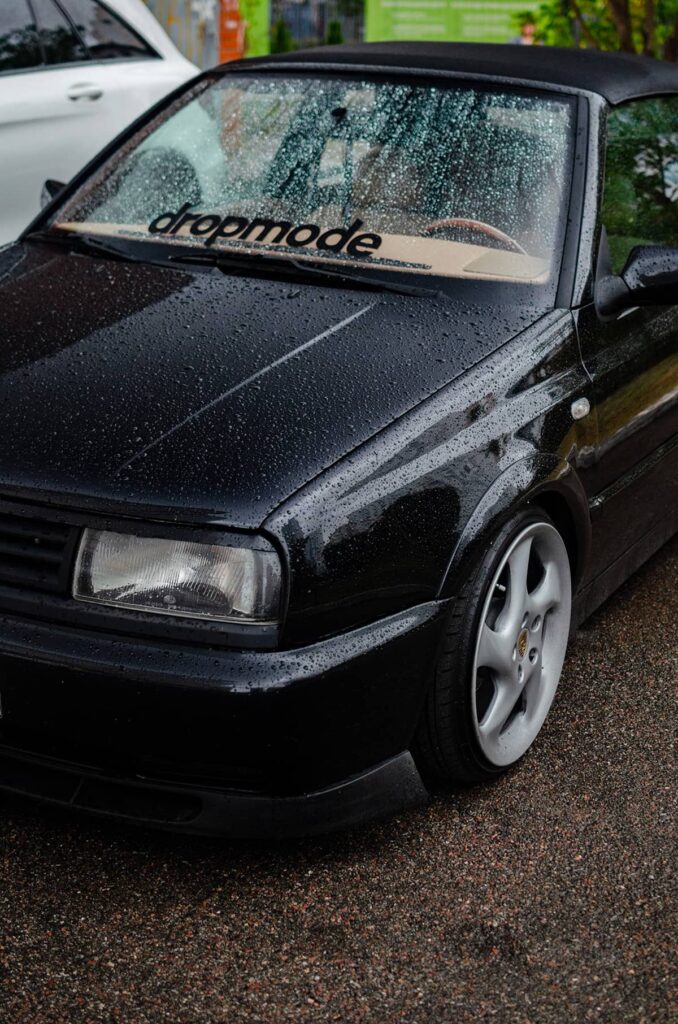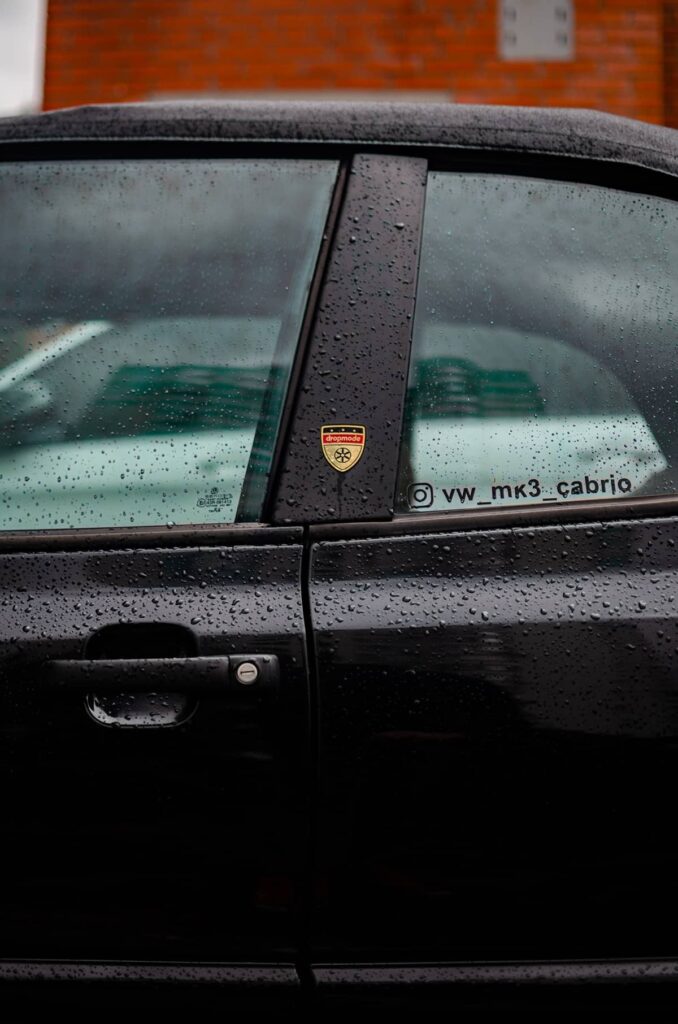Are Convertible Tops Waterproof? Fabric vs Vinyl

Convertible tops allow drivers to enjoy open-air driving when the weather is nice. But what happens when the skies open up and it starts to pour? Are convertible tops waterproof enough to keep the interior and passengers dry? This is an important question for any convertible owner.
In this post, we’ll explore the waterproofness of convertible car tops. We’ll look at what makes a convertible top waterproof in the first place, like waterproof membranes and tight seals. We’ll also discuss common causes of leaks and the types of damage weather and road conditions can inflict on vulnerable convertible tops over time. Proper maintenance and care is key for longevity, so we’ll also provide tips on preventative cleaning and when you may need to enlist professional help with replacements or repairs for your top.
Yes, convertible soft tops are waterproof, meaning they protect the interior from rain and moisture, but the upper layer of the fabric tops does not repel water(unless treated with special protectants), that’s why it needs some time to try out. Vinyl soft tops naturally don’t allow the water to soak up into it and remain dry.
Key Takeaways
| Topic | Summary |
| Convertible tops can be waterproof with proper membranes and seals | Most leakage comes from degraded seals or membrane damage |
| Vinyl tops offer better water protection than fabric | Proper specific cleaning and maintenance is crucial for waterproofness |
| Professional help is needed for leaks, replacement, or significant damage | Harsh weather and road debris risks waterproofing over time |

Materials
Convertible tops are comprised of an outer fabric or vinyl layer, interior padding and lining, plus mechanical components like windows and seals that allow the top to open and close over the passenger compartment.
What Makes a Convertible Top Waterproof?
For a convertible top to effectively keep the interior dry, it needs a waterproof barrier like a membrane layered into the outer fabric or vinyl material during manufacturing. This membrane prevents liquid moisture from seeping through while allowing water vapor to pass so condensation does not build up between the exterior and interior padding. High quality rubber seals along the edges of the windshield, doors, and rear window are also crucial water barriers.
The Role of the Waterproof Membrane in Convertible Tops
The waterproof membrane is essentially an internal layer of the exterior fabric or vinyl that blocks liquid water from getting through while enabling water vapor molecules to pass. This prevents condensation buildup inside the material. The membrane is made of materials like acrylic, urethane, or polyvinyl chloride (PVC). Quality and proper installation of the membrane are important for functionality.

Fabric vs Vinyl: A Comparison
There are pros and cons to both fabric and vinyl regarding waterproofness:
- Fabric – More breathable but requires more weatherproof treatment to repel water initially. Prone to leakage over time as fabric wears or mold develops.
- Vinyl – Better inherent water resistance but can become brittle when exposed to years of sun and weather. Typically needs replacement sooner than fabric.
Causes of Leaks
While well-made cabrio tops are designed to prevent water intrusion, leaks can still occur over years of wear and tear or due to damage. Understanding common causes of leaks helps diagnose issues.
Common Causes of Water Leaks in Convertible Roofs
There are a few typical ways water sneaks into convertibles during rain or car washes:
- Degraded windshield, door, or window seals
- Small punctures, cracks, or holes in fabric/vinyl exterior
- Poor drainage from clogged sunroof drains or channels
- Damaged or disconnected internal padding and lining
- Leaking trunk seals allowing access from folding top compartments
Careful inspection of seals, lining, and the outer material can pinpoint leakage sources. Trouble spots tend to be along seams and edges.
How Drainage Systems and Rubber Seals Affect Waterproofing
Convertible tops are designed with sunroof-like drainage systems to prevent water pooling. Clogged drains or channels force water between layers or down into the interior. Supple, uncracked seals are also imperative to block moisture especially during high-pressure car washes. Periodic inspection and seal reconditioning helps maintain water resistance.
The Impact of Neglected Seals on Leaks
Rubber seals get brittle and cracked over years of sun exposure and extreme temperatures. Small cracks then allow streams of water through during storms or automatic car washes. Wind noise or dripping water inside the cabin during rains indicate degraded seals. Replacing damaged seals right away prevents further water damage to interior linings and components.

Types of Fabric Damage
Over years of exposure to sun, wind, rain, and road debris, convertible tops can become damaged in ways that impact waterproof functionality. Understanding common damage helps assess when repairs or replacement are needed.
Weather Conditions
From UV exposure to extreme heat or intense storms, typical weather takes a toll on convertible top canvas over time:
- Sun damage – Sun’s UV rays can degrade fabric and vinyl, causing brittleness, fading, and cracking.
- Temperature extremes – Heat can accelerate material breakdown while cold cracks seals and materials.
- Rain and wind – Storms stress seams/seals allowing moisture access and pool if drainage is inadequate.
Routine UV and weather protectant treatments help minimize degradation. Staying on top of damage avoids bigger leaks.
UV Sunlight
Specifically, sunlight is tremendously damaging to convertible top materials like fabric and vinyl. Ultraviolet radiation degrades the exterior layer, accelerating wear, causing discoloration and brittleness. This leads to cracks allowing water intrusion. Regular applications of UV protective treatments are essential. Replace significantly sun-damaged tops.
Branches and Road Debris
Driving with the top down also exposes the exterior to errant tree branches, flying gravel, and other road debris which can inflict punctures, tears, or holes. Careful driving helps avoid this damage. Multi-layer convertible top construction helps minimize penetrations through the full thickness. But significant damage should be patched or the top replaced if unrepairable.
Maintenance and Care for Convertible Tops
Like any vehicle component exposed to the elements, diligent maintenance and care is key for longevity of convertible tops. Here are some best practices:
How to Prevent and Fix Leaks
- Inspect seals and linings for cracks annually before winter
- Clear debris/leaves from sunroof drains and channels
- Recondition cracked seals with rubber conditioners
- Patch small exterior holes/tears with waterproof vinyl patches
- Replace significantly damaged top components
The Importance of Regular Cleaning and Treatment
- Wash tops every 2-3 months with mild soap and water
- Rinse debris that collects along seams or windows
- Apply UV and weather protectants 1-2 times per year
- Park under a garage to minimize sun/weather exposure
Cleaning Products
The products below help keep tops clean, conditioned, and water-repellent:
- Mild car wash soap and water – Safely lift dirt without damaging exterior
- UV protectants – Prevent sun damage and condition materials
- Plastic/vinyl cleaners and sealants – Clean without erosion and seal pores
- Water repellent sprays – Renew water beading effect on fabric or vinyl
Avoid harsh cleaners which can strip protective coatings or bleach materials. Test products first on inconspicuous areas if uncertain about compatibility.
When to Enlist Professional Help
Bring vehicles with chronic, mystery leaks to service departments. Mechanics have diagnostic tools to pinpoint internal water sources unaffected by exterior reconditioning. This avoids wasting time and money on products that cannot resolve structural issues.
Replacement Options
For convertible tops where UV damage, tears, holes or leakage is too extensive for repairs, replacement restores full functionality. Whether fabric or vinyl, factory or aftermarket, professionals ensure proper material choice, sizing, seal integration and installation for lasting waterproofing protection.

Expert Opinion
After 10 years of owning a convertible, I’ve learned quite a bit about keeping these tops waterproof for rain-free, open-air driving. Proper maintenance is truly key – consistently cleaning the top, reconditioning seals, and applying UV treatments makes all the difference. I clean my convertible top every month with a gentle cleaner and water, make sure to hit seams and edges where grime collects. Before winter I apply a sealant to protect my top from temperature extremes. And I treat the vinyl with a UV protectant 2-3 times per year to prevent cracking. Staying diligent with basic care has kept my original top in great shape all these years without any leaks.
Conclusion
Ultimately, convertible tops can be waterproof when well-made and properly maintained. While vinyl tops initially resist water better, fabric tops also deliver dry open-air driving when cared for diligently. Applying sealants and UV treatments, clearing debris from sunroof drains, and promptly patching holes are critical for longevity. And if leakage persists despite best DIY efforts, don’t hesitate to involve professional diagnostic and repair services to restore full function.
Frequently Asked Questions
Most convertible soft tops are designed to be waterproof with internal membranes and quality seals. But no top is impervious without proper maintenance. Neglected seals, clogs, and exterior damage can lead to leaks over time.
The majority of leaks come from degraded windshield, door, or window seals that crack after years of exposure. Holes, blocked drainage channels, and disconnected liners are other common culprits.
Vinyl tops initially resist water intrusion better thanks to the material’s properties. But with timely cleaning, seal upkeep, and preventative treatments, well-maintained fabric tops also deliver dryness.
Ideally, we recommend to clean them with soap and water every 2-3 months. Apply protective sealants and UV resistant coatants 1-2 times per year to protect from seasonal damage. Inspect seals before winter.
Yes. The worst thing is that your roof will get wet. Convertibles can safely handle brief, light showers thanks to waterproof membranes and seals. Avoid extended downpours or high speed driving on highways that exacerbates wind-driven intrusion.
For minor pinholes or tears under 2 inches, waterproof vinyl patches can often adequately seal small leaks. Any larger holes or microscopic leaks at folded seams will likely require full top replacement.
It’s best to avoid leaving convertibles fully exposed in heavy rain. Move the vehicle undercover if possible or use a high quality car cover temporarily. Light showers are fine but move convertibles out of drenching storms when feasible. While well-designed convertible tops are made to get wet during use and resist leaking, questions still come up from owners wondering “can convertible tops get wet” in the rain without damage over time.
In-house writer and editor at CabrioNation. I've been a lifelong fan of convertibles ever since my first car, a well-worn Bimmer convertible that I learned to maintain from the ground up. Since then I've owned many soft and hard top models, becoming an experienced DIY mechanic and care taker. I also run a small repair shop and rental service in Montpellier, where I get to share the wind-in-your-hair feeling with customers while also helping fellow cabrio enthusiasts on maintenance and top repairs.



My convertible top is 5 years old and just started leaking. Time to treat those seals before it gets worse!